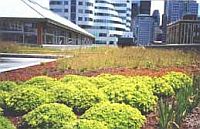Saturday, April 20, 2024
News and Views from the Global South
ENVIRONMENT-US: Growing Oases in the Sky
Enrique Gili* - IPS/IFEJ
- An industrial park seems an unlikely location to find a native plant garden.
As the founder and president of Good Earth Plant Co., a container plant and design firm, Mumford combines business acumen with the enthusiasm of an amateur naturalist. He wants to turn neglected urban landscapes into green space for workers and wildlife, beginning with his own commercial property in the gritty neighbourhood of Kearny Mesa, San Diego.
According to Mumford, there's 500 million square feet of available commercial and industrial space in San Diego alone. Add to that number the millions of underutilised roofs in hundreds of large to mid-sized cities and you might have enough acreage to seed all the cornfields in Iowa.
Part of the recent trend towards erecting eco-friendly buildings, green roofs are popping up like mushrooms after a spring rain in metropolitan areas throughout the United States and Canada. They are perceived as one solution to soaring energy bills and the need for more green urban space among concrete canyons.
For example, Environment Canada found that a typical one-storey building with a grass roof and 10 centimetres of growing medium would cut summer cooling needs by 25 percent. Other studies have found that a 15-centimetre green roof reduced heat gains by 95 percent and heat losses by 26 percent compared to a traditional roof.
"All of a sudden the environment is part of the mainstream conversation," Mumford says.
A modest 1,800-square-foot building is the first of three structures on Mumford's sprawling property slated for renovation – an undertaking that he's not taking lightly since the project is entirely self-financed. "Through my ass and through my cash," Mumford explains bluntly.
He's calculated the green roof cost to be approximately twice that of tried and true methods of roof construction. But the payoff, he believes, will come in the form of a myriad of environmental and cost-saving benefits.
Inside his office, Mumford has already noticed a marked difference. The drone of single-engine planes taking off from a nearby airfield has been muffled. His expects to save 20 to 25 percent on his utility bills, which over time will help offset the added cost of construction. And rather than redoing his roof every 10 to 20 years, he believes his green roof can last up to 60 years if installed and maintained properly.
Like most fast-growing cities, San Diego replaced its native landscape with black asphalt and gray concrete, leading to an urban weather phenomena know as the heat island effect. A hardscape devoid of vegetation creates its own climate, raising the temperature by 2 to 10 degrees C. in cities compared to surrounding rural areas. That combined with global warming presents a challenge to making cities amenable to humans.
Green roofs are still few and far between in southern California because of the unique challenges they present to landscape professionals. During mid-summer, the surface temperature on Mumford's roof is 170 degrees, rivaling the nearby Anza Borrego desert in terms of heat intensity.
"I couldn't have found a harder project to experiment with," he concedes, listing the soil requirements native plants need to grow and thrive on a small plot of land that's essentially one gigantic flowerpot. "It's hot, windy and dry."
Not content with cacti, he's planted a variety of drought-tolerant native plants noted for their hardiness and low maintenance requirements.
Resembling a raised garden bed, the green roof is a multi-layered polymer membrane overlaid with a plant growing medium used to provide nutrients and retain moisture. The design challenge is to prevent leakage and yet remain lightweight.
Green roofs are not new. Germany began subsidising their construction during the 1960s in order to prevent storm water runoff. Since then, they have morphed from being architectural oddities to comprising 12 percent of the flat roofs in German skylines.
Forward-thinking mayors and planners in the United States are also reimagining what sustainable cities might look like. Portland, Chicago and San Francisco continue to sprout green roofs that keep getting larger in scale and complexity.
The trend has culminated in the construction of a massive green roof resembling a living ecosystem atop the California Academy of Science in San Francisco. The building housing the Academy's natural history collection is making way for a 197,000-square- foot green roof carpeted with plants native to California.
Steven Peck, founder of the nonprofit organisation Green Roofs for Healthy Cities, takes a professional interest in green roofs, studying many of the large-scale projects built in the United States and overseas. He is harvesting data to produce a soon to released cost-benefit analysis.
An economist by trade, Peck understands the difference between what's possible and what's feasible from a public policy standpoint. Without a regulatory scheme that provides incentives to build sustainable cities, green roofs won't have much of a foundation, he says.
Green roofs also have to overcome resistance from real estate developers reluctant to place additional load-bearing structures on roofs, citing fears of flooding and the added costs of construction.
Peck noted that the implementation of green roofs in North America is just beginning to take off. So far, the U.S. and Canada have completed 3 million square feet, versus the 3 billion already installed by German contractors.
Having said that, North America is undergoing a green roof construction boom, with continued demand expected to grow in the double digits well into the next decade
"There's not enough expertise to meet the needs of the market," Peck says. And that has to be good for butterflies and businessmen.
(*This story is part of a series of features on sustainable development by IPS and IFEJ – International Federation of Environmental Journalists.)

 Print
Print




